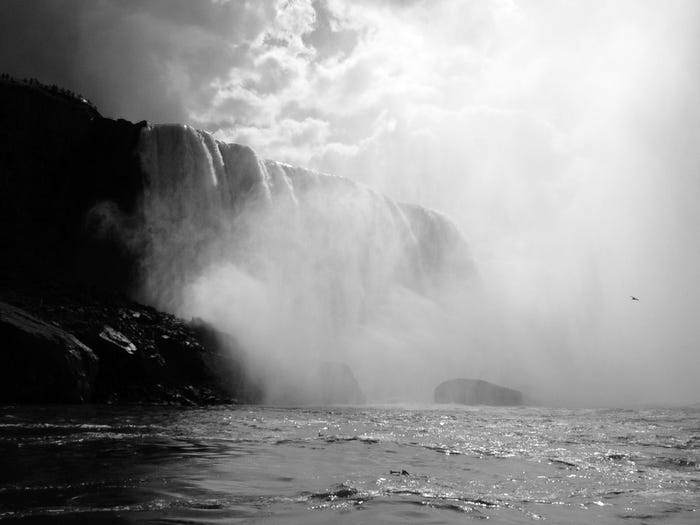Before I worked in games, I was in TV and film production. Before I was in TV and Film production, I was in film school. Before I ever shot a moving picture, I took a photography course, and before I took that photography course, my Grandfather, Larry S. Cohan, taught me how to shoot photos.
Grandpa also taught everyone in our family how to use computers. He should know, he’d been working on them since the 1960s. (Yes, the ’60s. The reel-to-reel ones being installed on Navy Ships.) I heard opinions about the difference between Mac and PC devices long before John Hodgman and Justin Long made it a TV campaign. He fell in love with photography later in life and approached it like a programmer, thinking very hard about the inputs of shots, and what kind of outcomes they’d produce.
In Fall 2009 he was published a (still-archived) story called “Better Photos—No Cost” in a Maryland magazine called Outlook by the Bay, a publication for senior citizens of the Chesapeake Bay region. It documents the basics of photography he didn’t just share with me but seemed obsessed with everyone having some understanding of.
Some of his grumpiness still drips off the page. “Don’t bore your friends with photos that would bore you if they weren’t your own,” he wrote. “If you’re shooting the sunrise over Bar Harbor, Maine, don’t try to include your half-asleep spouse.” Sarcasm was a second language for Grandpa, but I remember he seemed sincerely frustrated at how his peers didn’t understand the basics of photography, equaled only by his frustration of how they were intimidated by computers.
Photo by Larry Cohan.
For Photography Week, I revisited his guide and thought about how he was trying to teach fellow retirees better ways to take shots. They’re good tips—ones I still think about when having fun in a photo mode like the ones in Pacific Drive, Star Wars Jedi: Survivor, or Marvel’s Spider-Man 2.
They’re so good, in fact, that they could help you make a better photo mode for your next game. Let’s run through them and think about how they could make for better photo modes.
Can you help players figure out what needs to be in the frame?
“One purpose, on purpose,” is one of the first tips Grandpa Cohan wrote. “Think for just a few seconds about the purpose of the photo you’re about to take. Compose in your mind before you compose in the viewfinder.”
Most modern games look so great just grabbing a screenshot of a moment in combat will catch the eye. When players open photo mode, they’re committing to going a step further, maybe with a purpose in mind—but maybe not. Maybe they know there’s a good shot here, but they don’t know what it is yet.
The most helpful tool I’ve seen here are the poses and facial expressions found in the most recent games from Sony’s first-party studios like God of War: Ragnarok, Horizon Forbidden West, and Marvel’s Spider-Man 2. Sony Santa Monica, Guerilla Games, and Insomniac Games all built tools that let players customize character poses and facial expressions. These can help players pick that “purpose.” Should it be goofy, with Aloy doing a silly pose as a Thunderjaw rears at her? Or should it look like a comic panel, with Spider-Man’s eyes going big and bug-eyed as he takes a punch?
He was always fixated on what should go in a frame. Photo modes have done a great job on this front, offering players guides to match “the rule of thirds.” “Do not center the subject,” he wrote, the emphasis so strong I can hear him saying it years later. He wanted amateur photographers to learn not to “vertically center” the horizon in landscape shots, making sure the photo was one-third sky and two-third ground, or vice versa.

Photo by Larry Cohan. First printed in Outlook by the Bay.
Quickly shooting multiple angles was another trick up his sleeve, promising readers they’d be “glad” they took “at least four shots” of a scene from different angles. Here he could introduce the idea of how photos looked different at a 45-degree angle, or how they’d look from the ground-up or from overhead. Ubisoft’s got a feature that makes this easy in Star Wars Outlaws, letting players set a “Camera A” and “Camera B” to flip between. I wonder if photo modes would benefit from creating Cameras C and D.
I don’t agree with his advice that should avoid “candid camera” shots. “When shooting a party, don’t try to be a photojournalist or Allen Funt shooting surreptitiously,” he wrote. Sometimes it’s just fun to snap and move on….is that true in games too?
Could photo modes get more ambitious, and have ways to preserve camera settings that players could trigger at flick of a button? Could you make it so players can pre-set an angle, lens type, and focal distance for “Camera A,” and press a key to have it ready to shoot a photo of the player character in an instant. We have “instant replay” modes that grab video from players at camera angles they don’t normally play in after all…
There’s plenty to think about in helping players set up a shot. But getting the light just right is a whole other ball game.
Look for the light
Grandpa hated the built-in flash of point-and-shoot lens. He was religious about scrubbing out that classic “red-eye” you’d get from photos that emerged because the flash sat so close to the lens. “These flash shots frequently are washed out or ghostly, showing harsh shadows and red eyes,” he penned. He urged most photographers without fancy lighting equipment to just turn the flash off and work off of natural light.
Again, Sony’s first-party studios have jumped ahead here in giving players control of lighting, but Square Enix has been toying with this in its photo mode in the critically acclaimed MMORPG Final Fantasy XIV. Lighting is hard though. I went through four years of film school and still smack my head in exasperation when I see the answer to a lighting question I failed to understand back then.
Most people think you have to point a light directly at your subject to “light” it, maybe adjusting it with a filter so they don’t think about how you can bounce the light off other objects to create softer or harsher shades depending on what they need.

Image via Respawn Entertainment/EA. Shot by Bryant Francis.
Basic time-of-day controls in games with day/night cycles will help players cue up the “golden hour” aesthetic, generally seen in the real world in the two hours after sunrise and the two hours before sunset. This is when colors from the sun’s light are warmer, the shadows are longer, and the angle on the light is in a space to not generate what Grandpa called “raccoon eyes.”
But lately I’ve been frustrated by how even if you can set the time of day in a photo mode to perfect golden hour time, you’re still stuck with where the in-game sun is physically located in the game world. If we’re at a point where players can add in-game light sources to fill in shots or change the type of lighting in the scene, could developers allow the sun itself be moved around the same way?
(The lighting programmers in the comments are probably screaming at me).
How do players share screenshots these days?
Grandpa’s last advice for Maryland retirees has to do with how many photos you share with your friends. His hypothetical stinger at the end about “Aunt Rose” handing the reader 128 prints while hovering over them might be close to home, given his mother’s name was Rose. Reading this, it occurred to me—how do players even share screenshots with each other now?
Capture technology on consoles is easy but the degrading APIs of Twitter and Facebook mean you can’t share screenshots directly from PlayStation, Xbox, and the Nintendo Switch anymore on the formerly dominant social media sites. TikTok and Instagram integration never took off. Every platform would love you to just send screenshots to your friends on their system but look, I don’t remember using PlayStation’s “send to a friend” feature any time recently, do you?

Image via Square Enix Montreal/Square Enix. Shot by Bryant Francis.
We’ve got all these great photo modes but no way for players to curate what they want to share. The mode that jumps quickly to mind would be something like Elden Ring‘s player messages or Death Stranding‘s structures—systems in games that could proliferate screenshots to players everywhere. Ubisoft ran with this for a while in its newer Assassin’s Creed games, surfacing photos on the in-game map, but I think that feature may have been more disruptive than helpful, at risk of spoiling content best left unspoiled and taking up space needed for icons.
Grandpa was complaining about Aunt Rose’s 128 prints and I’m sitting here shuffling a flash drive around to show you a few photos created in an entirely digital world. Something’s gone wrong in the sharing section of photo modes, and it sure would be great to have it back.
Helping players have fun with photography
Larry Cohan passed away in 2011 at the age of 75—before I was out of school, before I was working in games. I regularly catch myself going “I wish I could have shown him this” when booting up photo modes, or digging into how game tools work. He’d have understood so much of it—his favorite pastime in the ’90s was playing flight simulators like LucasArts’ Secret Weapons of the Luftwaffe.
He wrote this photography guide because he was frustrated by how few people around him understood how to take good photos, but there’s something under the frustration that rings through my memory. Grandpa could be extremely literal, often stubborn (like me). I think we shared certain challenges with cognitive load that could make complex ideas painfully difficult until we had that breakthrough.

Photo by Larry Cohan.
One of the game-related memories I have of him was being frustrated nearly to the point of tears as I tried explain how the Nintendo Wii worked. He seemed frustrated too. I felt like he was frustrated with me, who couldn’t communicate that the Wiimote used motion sensors and infrared tracking to work their magic. I wonder if he was frustrated with himself too, since he couldn’t picture how the technology worked just based on my description of it.
There’s a sense of “I figured it out, surely you can too!” in his writing, and I wonder if he at one point was having a hard time understanding how photography worked, and if he needed it broken down to the basics to understand how the aperture, shutter speed, and ISO all worked together. When he did figure it out, he enjoyed the hell out of it, and wanted other people—his family included—to have fun with it too.
His method for teaching that fun could be didactic. Games, thankfully, don’t have to be. Free from the interface of physical cameras, we have tools to help players snap great shots and have fun doing it all at once.
Finding the fun drives motivation, and motivation can help players understand the art of photography—an art form so potent it can bring tips my Grandpa penned for retirees in Outlook by the Bay forward in time to an outlet for game developers that used to have a sex pun for a name.












